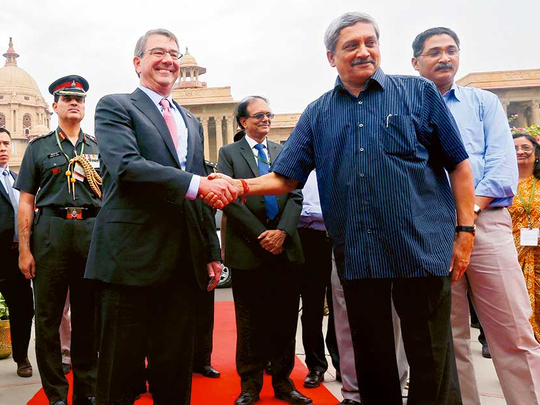
New Delhi: After several years of bureaucratic delays, the US and India are moving ahead with two joint research projects for the military that officials hope will set the stage for greater defence cooperation in the years ahead.
Defence Secretary Ash Carter and Indian Defence Minister Manohar Parrikar were to sign a defence agreement Wednesday, as part of a broader US effort to improve what has been a rocky relationship between the two countries. The US views India as a key ally in the Asia Pacific, in part as a countermeasure to China and a linchpin in America’s effort to deepen military and diplomatic ties with countries at Beijing’s doorstep.
Carter acknowledged the difficulties on both sides in breaking through the red tape to achieve more development cooperation, but said things are moving forward.
“There is a legacy and historical burden of bureaucracy in both countries, and it’s a constant exercise in stripping that away,” he told reporters travelling with him. “It’s the burden that we carry forward from the fact that we were two separated industrial systems for so long during the Cold War. It just takes time to get the two of them together.”
The latest, more tangible progress in the development projects, include two $1 million (Dh3.67 million) research ventures. While small, defence officials say the two-year projects will set the groundwork for future collaboration.
“Some of the projects that we’re launching just now are, in part, intended to blaze a trail for things to come,” Carter said.
One of the projects moving forward is the development of a high-tech mobile power source for the Marine Corps that would work on solar energy, be smaller, more portable and efficient, and could be used in remote outposts.
The other is a protective suit for the Army that would be more lightweight and effective when used in chemical and biological hazard incidents. Other possibilities down the road include collaboration on some aircraft carrier and jet engine technology.
US leaders have long hoped to partner more with India as it modernises its military, but Indian leaders have been more interested in co-development opportunities than in simply buying American-made weapons.
India has also been courting a strong business relationship with China. Beijing sees India as a market for its increasingly high-tech goods, from high-speed trains to nuclear power plants, while India wants to attract Chinese investment in manufacturing and infrastructure.
At the same time, however, India has been concerned about China’s quest for greater influence and increased military activities in the Indian Ocean.
One theme of Carter’s trip here was greater maritime cooperation, and to underscore that he began his visit Tuesday with a stop at India’s Eastern Naval Command in the port city of Vizag. He toured a navy ship, the INS Sahyadri, before flying on to New Delhi.
Carter’s visit comes on the heels of stops in Singapore and Vietnam, where strains with China and its land reclamation and other operations in the South China Sea were key topics of discussion. And he repeatedly stressed that the US military will continue to partner with Asia Pacific nations and have a strong presence in the region..
The US effort to do joint projects with India got a boost through the efforts of Indian Prime Minister Narendra Modi, who is seen as more eager to work with America and wants his country to play a larger role on the world stage.
Then, earlier this year, during a visit by President Barack Obama, the two leaders formally announced the agreement to pursue four projects under the Defence technology and Trade Initiative.
The initiative was launched in 2012, and was led by Carter, who then was the deputy defence secretary. But progress was slow.
Last August, then-Defence Secretary Chuck Hagel in a visit to India, urged more defence cooperation, saying that government red tape and other problems should not stymie progress between the two.












